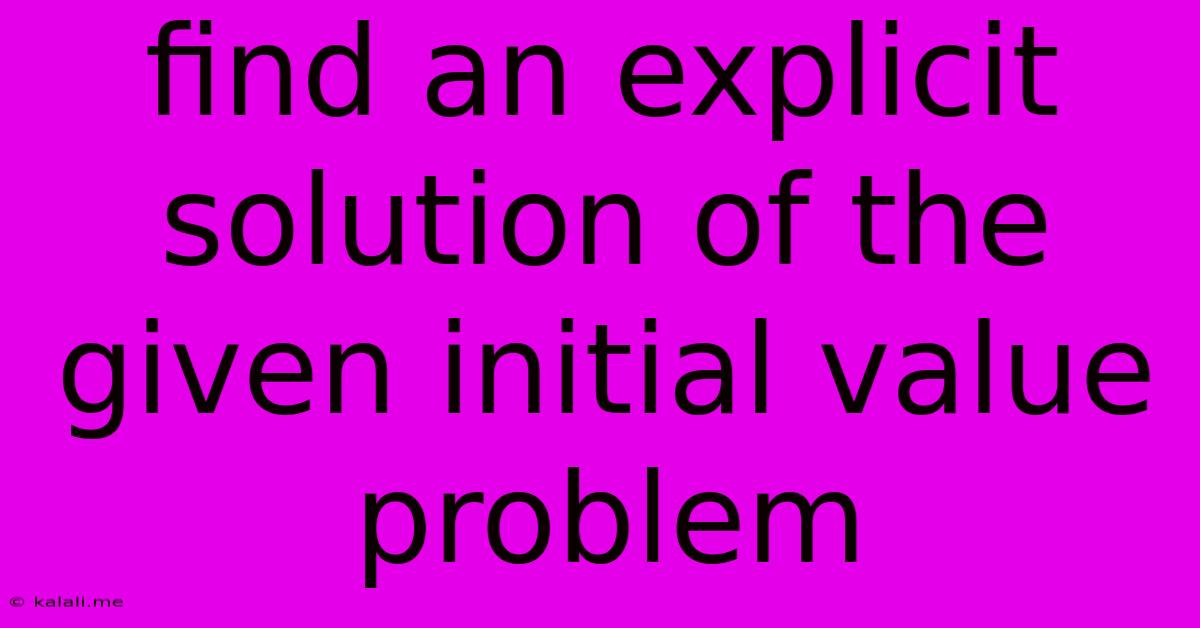Find An Explicit Solution Of The Given Initial Value Problem
Kalali
Jun 03, 2025 · 3 min read

Table of Contents
Finding Explicit Solutions to Initial Value Problems: A Comprehensive Guide
Finding an explicit solution to an initial value problem (IVP) is a fundamental task in differential equations. This article will guide you through the process, covering various methods and providing examples. We'll delve into techniques for solving different types of IVPs, offering a clear understanding of the steps involved and the underlying mathematical principles. This comprehensive guide aims to equip you with the knowledge to tackle a wide range of IVP problems.
What is an Initial Value Problem (IVP)?
An initial value problem consists of a differential equation and an initial condition. The differential equation describes the relationship between a function and its derivatives, while the initial condition specifies the value of the function at a particular point. For example, a first-order IVP might look like this:
dy/dx = f(x, y), y(x₀) = y₀
where f(x, y) is a given function, and y(x₀) = y₀ is the initial condition. The goal is to find the function y(x) that satisfies both the differential equation and the initial condition.
Methods for Solving IVPs
The method used to solve an IVP depends heavily on the type of differential equation involved. Here are some common methods:
1. Separable Equations
Separable equations are those that can be written in the form:
dy/dx = g(x)h(y)
To solve, separate the variables and integrate:
∫(1/h(y)) dy = ∫g(x) dx
Remember to include the constant of integration and use the initial condition to determine its value.
Example: dy/dx = 2xy, y(0) = 1
Separating variables: ∫(1/y) dy = ∫2x dx
Integrating: ln|y| = x² + C
Solving for y: y = Ae^(x²), where A = e^C.
Applying the initial condition: 1 = Ae^(0) => A = 1
Therefore, the explicit solution is: y = e^(x²)
2. Linear First-Order Equations
Linear first-order equations have the form:
dy/dx + P(x)y = Q(x)
These are solved using an integrating factor, μ(x) = e^(∫P(x)dx). Multiplying the equation by the integrating factor allows for simplification and integration.
Example: dy/dx + 2xy = x, y(0) = 0
Here, P(x) = 2x and Q(x) = x. The integrating factor is: μ(x) = e^(∫2x dx) = e^(x²)
Multiplying by the integrating factor and integrating leads to the solution. The initial condition is then used to determine the constant of integration.
3. Exact Equations
An exact equation has the form:
M(x, y)dx + N(x, y)dy = 0
where ∂M/∂y = ∂N/∂x. The solution is found by integrating a potential function.
4. Homogeneous Equations
Homogeneous equations can be written in the form:
dy/dx = F(y/x)
These are solved using the substitution v = y/x.
5. Numerical Methods (for equations without analytical solutions)
When an analytical solution is not possible, numerical methods like Euler's method, Runge-Kutta methods, or others are employed to approximate the solution. These methods provide numerical solutions at discrete points.
Conclusion
Finding explicit solutions to initial value problems involves a combination of understanding the type of differential equation and applying the appropriate solution method. While some IVPs yield straightforward solutions through integration, others require more sophisticated techniques or numerical approximation. This guide provides a foundational understanding of these methods, equipping you to tackle a variety of IVP challenges. Remember to always check your solution by substituting it back into the original equation and initial condition to verify its accuracy.
Latest Posts
Latest Posts
-
Three Houses Are Saint Statues Just For Byleth
Jun 04, 2025
-
How To Get Rid Of Dirt
Jun 04, 2025
-
Wd My Passport Ext4 Format Slow
Jun 04, 2025
-
How Does Rhythms And Bars Factor Into Lyrics
Jun 04, 2025
-
Macos High Sierra Bootable Usb Flash Drive Installer
Jun 04, 2025
Related Post
Thank you for visiting our website which covers about Find An Explicit Solution Of The Given Initial Value Problem . We hope the information provided has been useful to you. Feel free to contact us if you have any questions or need further assistance. See you next time and don't miss to bookmark.